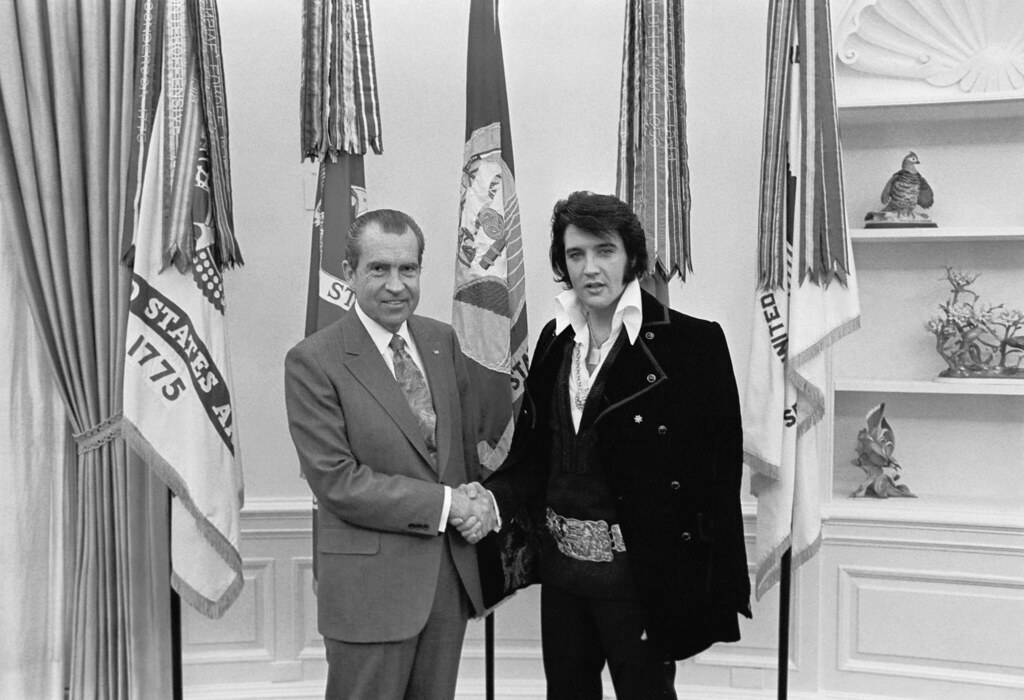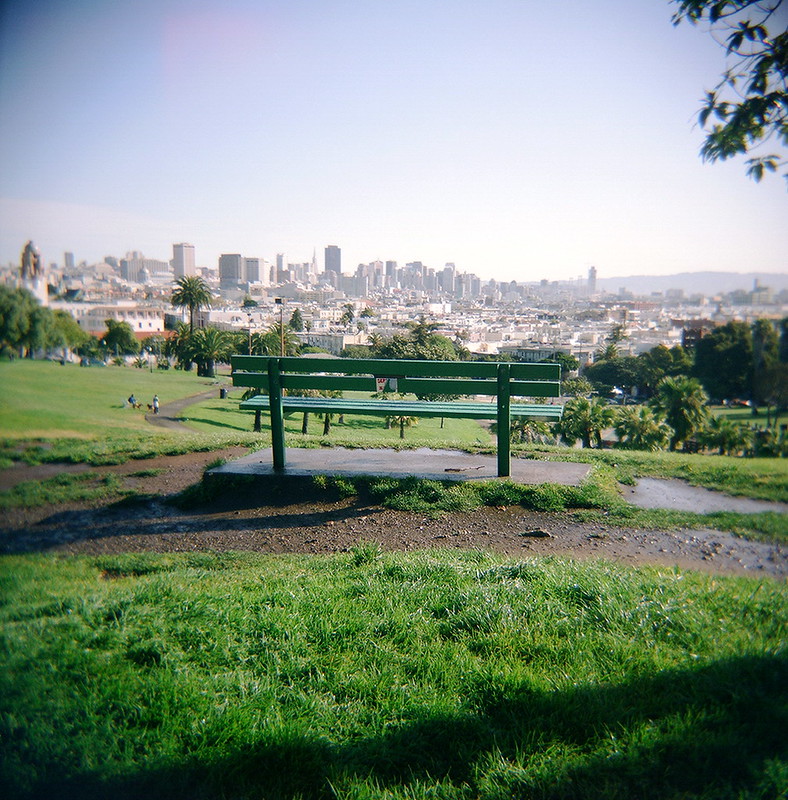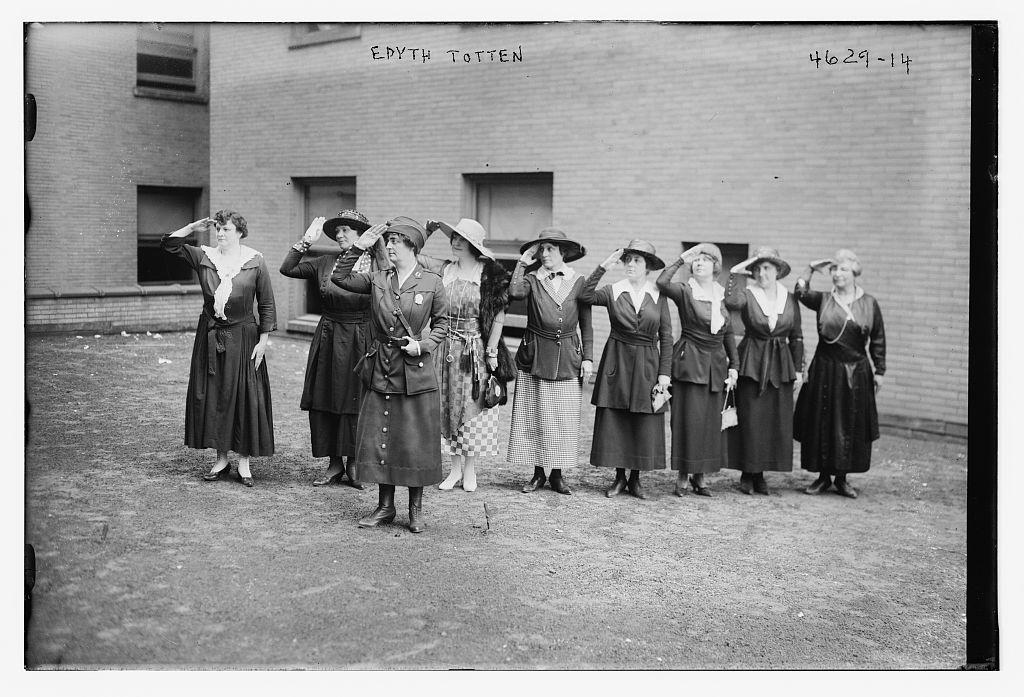“Does Alan only blog these days about Creative Commons images?” It. Seems. That. Way. But it’s a break from SPLOT, SPLOT, SPLOT.
But look, for this one you get a tool out of the deal, here it is before you have to wade through all my type-ridden, long-winded, whinge tinged verbiage.
Because it’s been around so long and adopted Creative Commons before most people even knew of it, the pool of open licensed photos in flickr is deep, wide, and fantastic (and hence dominates the search results at Openverse).
Yes Virginia, There is a Commons
A rather special, and almost invisible corner of the space is the Flickr Commons, that has a goal “to share hidden treasures from the world’s public photography archives” meaning images from museums, archives, and other institutions (a big list now), but more importantly, collections that are all in the public domain.
I don’t think the main page has changed much since it started in 2008, but the value is within:
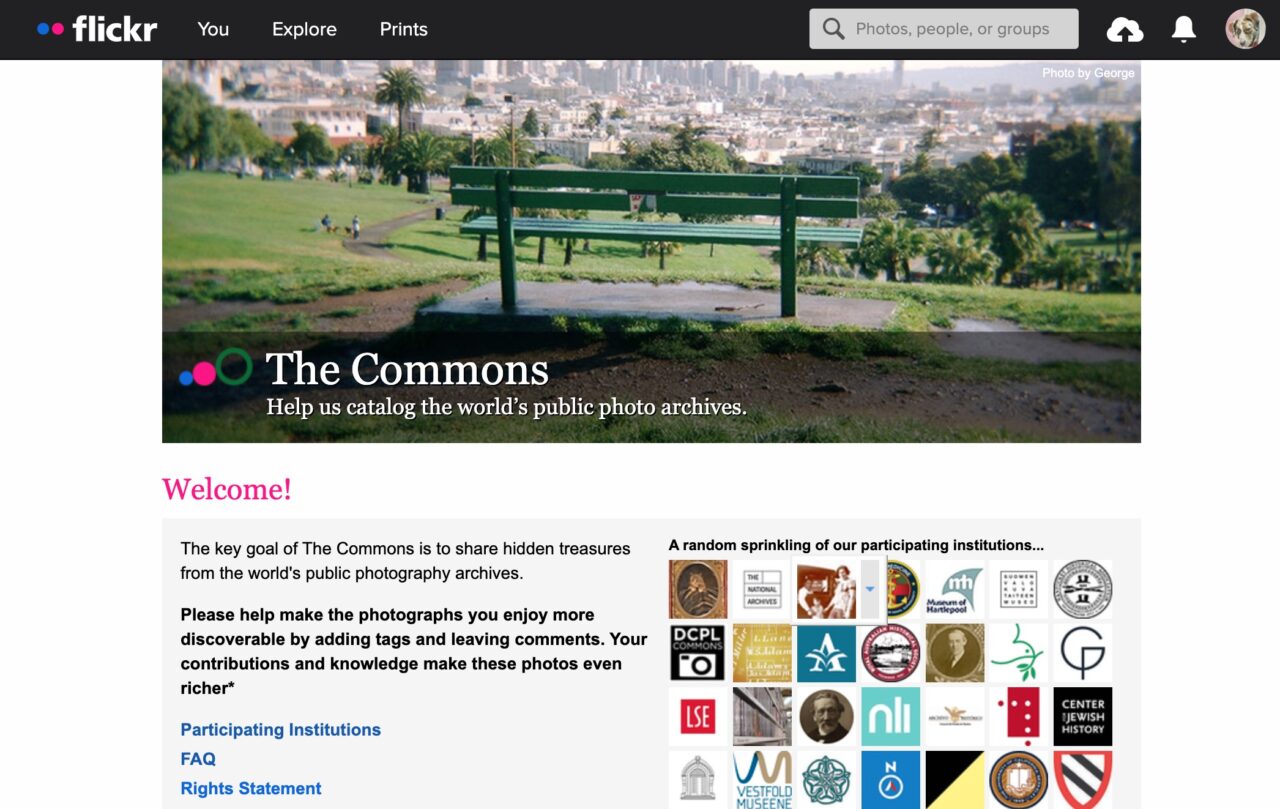
The objectives are key, first the obvious to “To increase access to publicly-held photography collections”. But it’s the second where the Commons comes to life, and what I like see even more valuable than just finding images:
To provide a way for the general public to contribute information and knowledge. (Then watch what happens when they do!)
https://www.flickr.com/commons
How? By comments! And even, I have seen the use of flickr’s notes annotation tool. For one of those examples, and certainly one of the oddest pairings of people, the time Elvis visited Richard Nixon in the Whitehouse (click through to see the comments and notes, not exactly historic, but, shrug)
(as a sidenote, this image holds a great memory for one of my favorite teachers I met my first day on the job at Maricopa Community Colleges, David Weaver, who in 1993 took up my challenge to learn HTML and made the first department web page for a physics department, that in the style of his humor, featured this photo. I have a blog post on this!).
Searching for the Search of the Commons
The Flickr Commons seems tucked away on the main flickr site. It is linked under the Explore menu, has anyone out there entered that way? And the only search means is a one field search box in the middle of that page.
Kind of like a lone bench in a park, the one in the image on the front of the Commons.
One night last week, I cracked open my CC Image Search bookmarklet making tools where I had one I no longer use for Google Images and one I do use now for Openverse. What’s so great about them? It’s the greatest thing since…
Well I do not have to visit a search site to search! Where ever I might roam on the web, say I am reading some weird blog, if I suddenly want to do a search on “slice bread” I can click the tool, enter keywords, and BOOM! see the sliced results
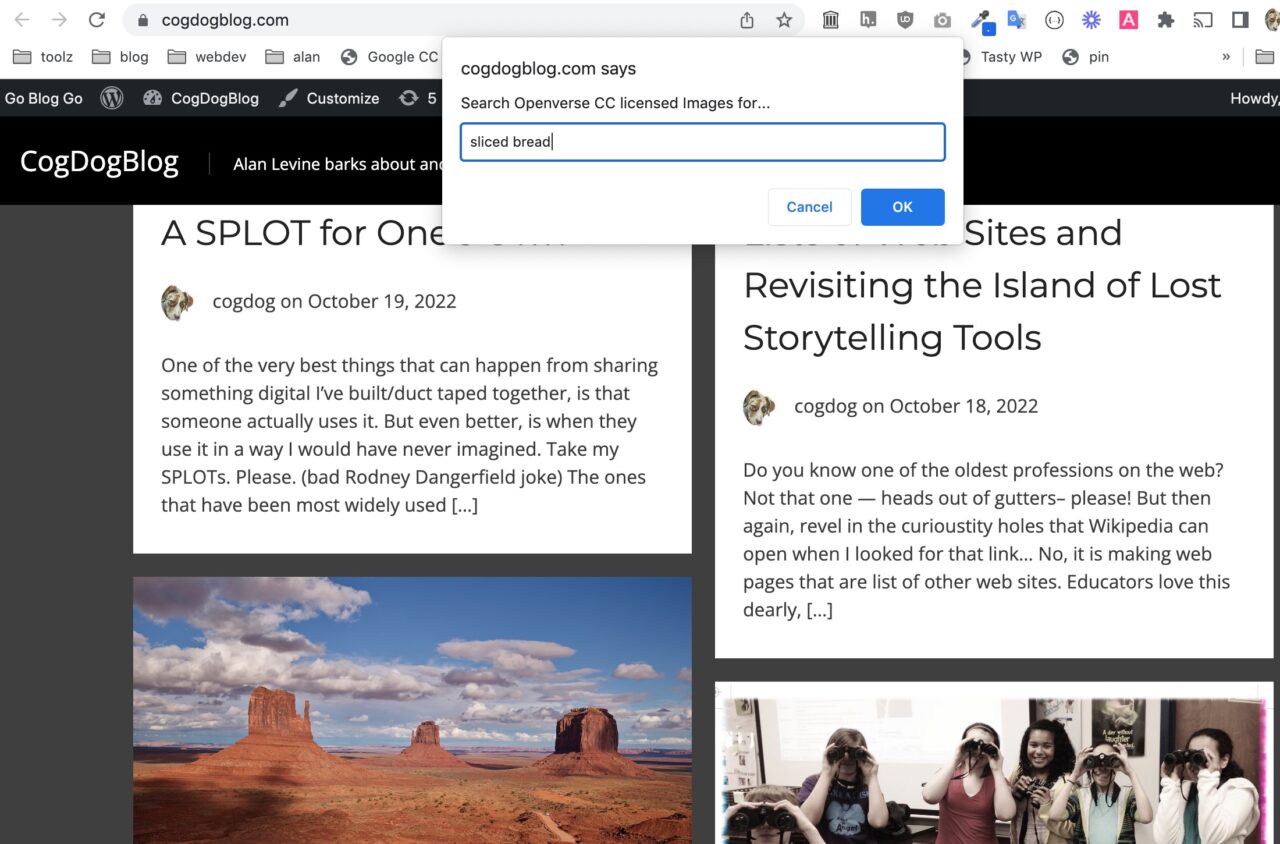
But wait, there is more. If I am reading text somewhere on the web, say a Wikipedia article about bread, I see the words making bread and think, that’s a metaphor I could use an image for! I just select the text, click my bookmarklet tool, and BOOM! BOOM! BOOM! results.
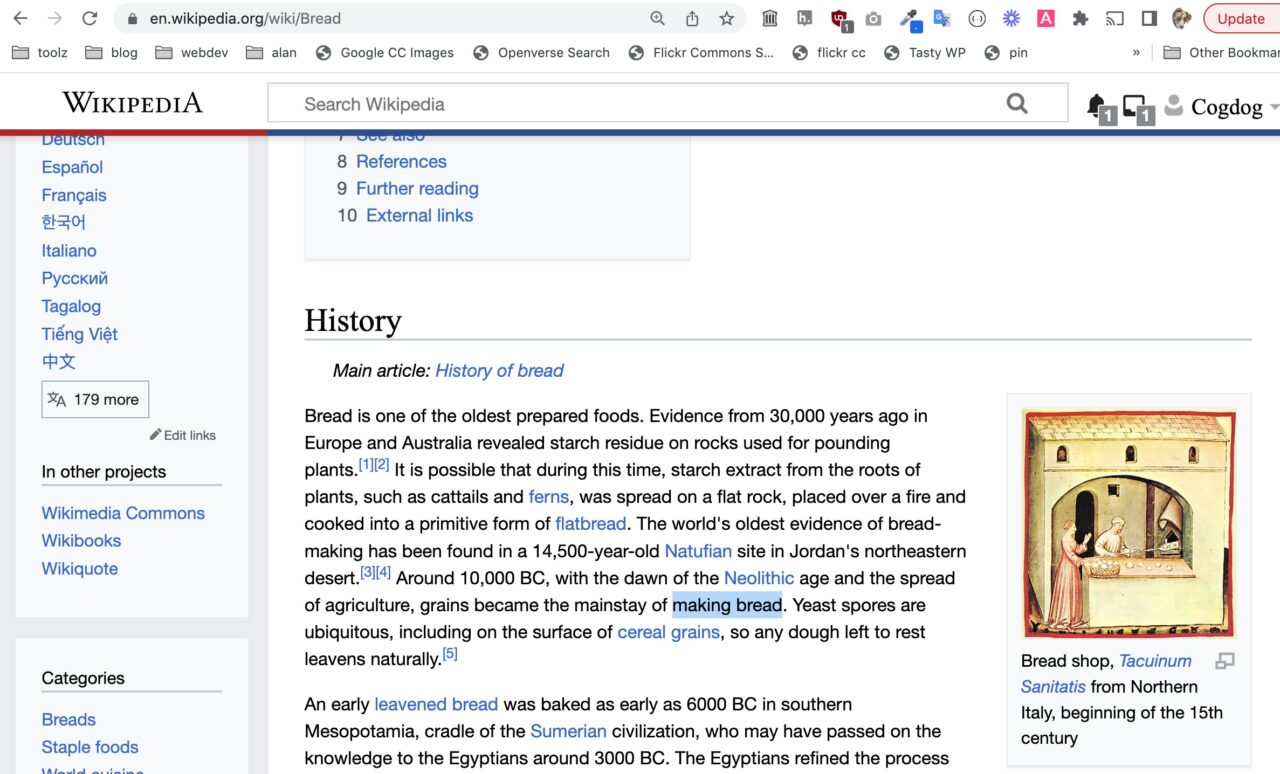
I have been using tools like this for over a decade, and they are at the top end of indespensible.
And just for fun, well and as you may actually read below I had a need, I just made the newest bookmarklet tool- to search the Flickr Commons
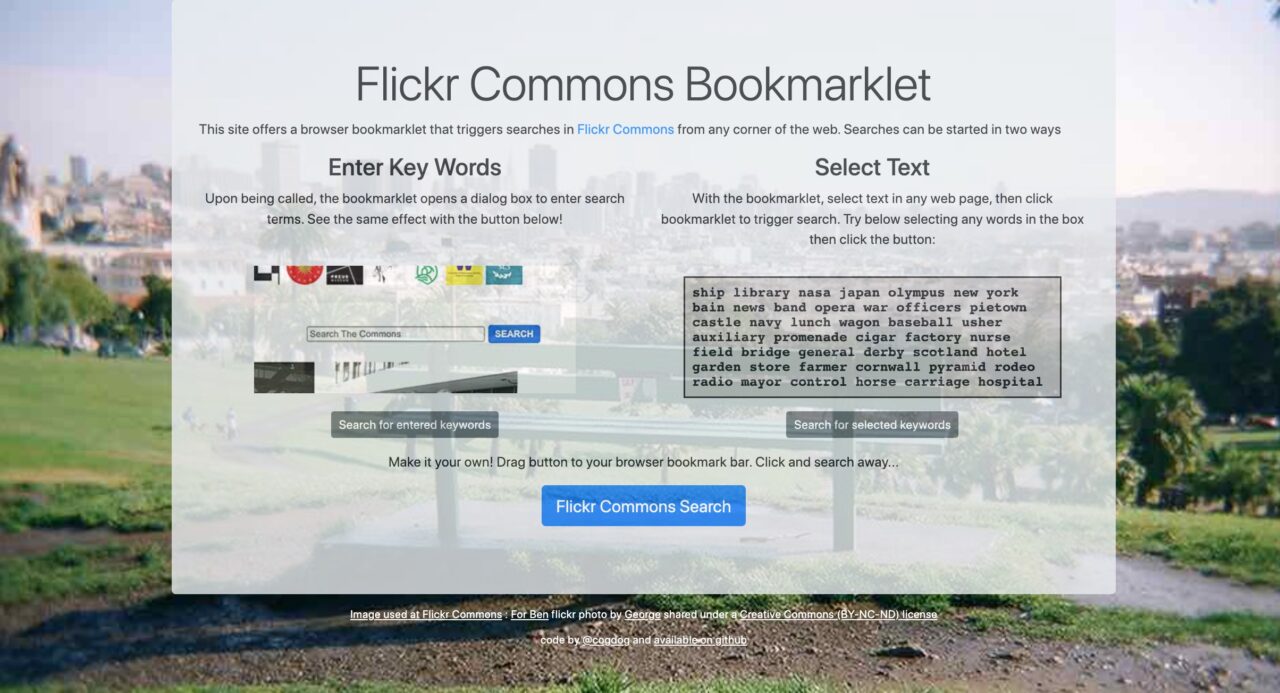
What does my search bookmarklet do? By definition, you access it any time you need it.
All the tool pages for the ones I built are are similar. You can try before you [don’t] buy. Use the button on the left for a keyword search or select text form a random list on the right to try that method. If you are gobsmacked, you can then install it by dragging the link for the Big Button at the bottom of your page to your browser bookmarklets bar. Bing! There’s a new tool at your reach.
A clever eye might notice I used the same background image of the park bench that appears on the flickr commons page. The image has a url pointing to a file named https://combo.staticflickr.com/pw/images/commons_dolores.jpg but where is that? Who is Dolores?
On a whim I did an google image search on “Dolores Park” and found indeed similar photos for a park by that name in San Francisco, The image was easy to located by a reverse image search:
And this makes sense as George Oates who worked there and created the Flickr Commons in 2008 (who recently came back on board to revitalize it)… a comment on the photo shows others had preceded me too with the bench finding.
I digress again…
This is technology I started doing in the mid? late 1990s, and it works better than ever.
But you may ask, with all these other search things out there, when in the heck to just want to search this one collection?
Why use a special search when you can find everything (sort of) in Google (well you cannot easily) or as I have been touting, im Openverse. I would aim for the commons if I was looking for historic or just old photos, saving me the trouble of having to add that as a keyword. Also, because these are the photos that do not seem to show up regularly in bigger search pools, you tend to find more original, even quirky images (I would also recommend Public Domain Review).
I had a different reason and it all comes from my dose of serendipity that comes from opening a new browser tab.
I am My Own Use Case
I’m hardly special for keeping a bunch of browser tabs open (in multiple windows). Each time you invoke a new tab to enter a URL or jut start a web search, you are greeted with the White Screen of Nothingness.
For a long time, I have gotten use, distraction, and often find images I can make use of via the Library of Congress Free to Use Browser extension. What does it do?
Each time I open a new browser tab, rather than an empty screen, I am served a random public domain image. Do I always need a distraction? No.I have stuff to do! But that small bit of unexpected imagery is often like a spurt of joy or curiosity. Usually I just go on about my business, but sometimes, an image is so evocative, I am drawn to learn more (I have blogged more than once about this).
Here’s an example that came up before I wrote the post.
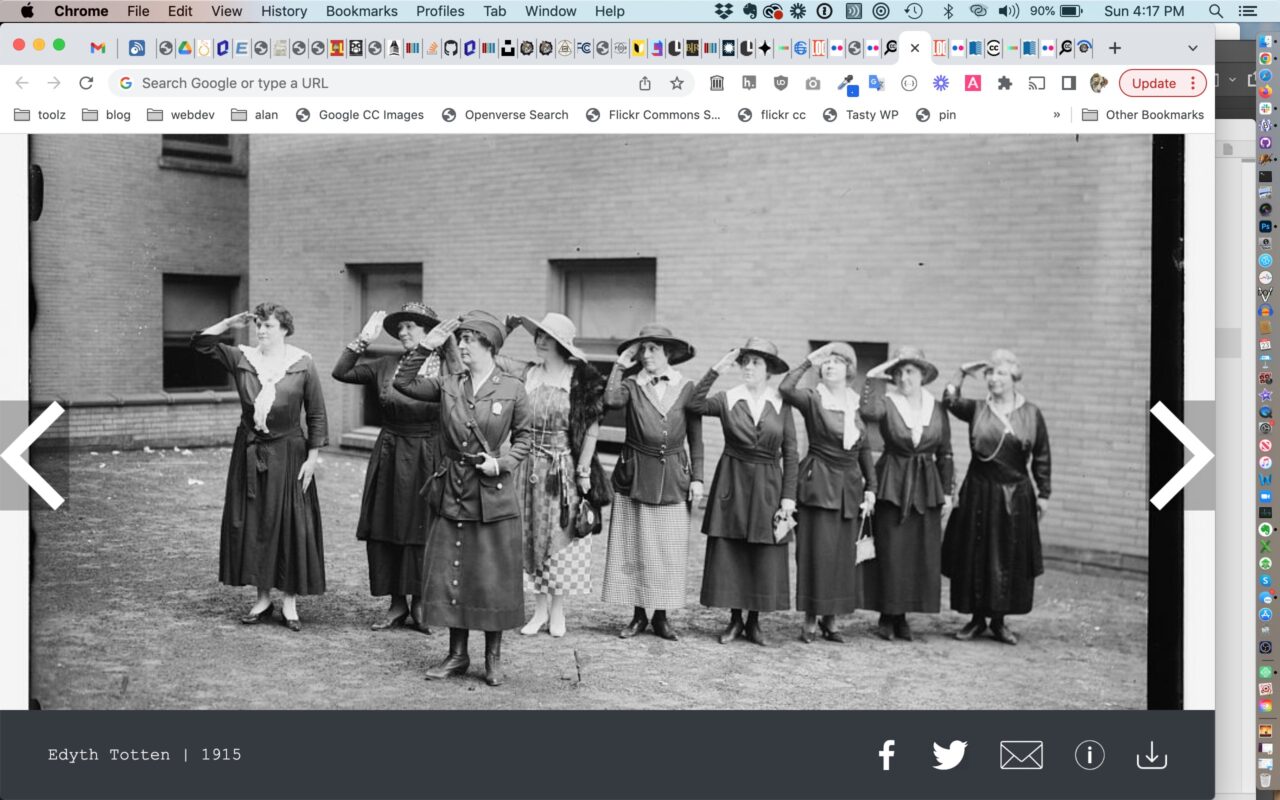
The thing is, if I go on with my browsing, I cannot easily return to this image. So I might leave open, share i, but usually, if the curiosity is strong enough, I hover to bring up the bottom grey bar, and click the image title to find its entry at the Library of Congress.
I can from here download it, but if my curiosity light is on, I read essentially what is the metadata stored with it, like the summary:
Photograph shows Major Edyth Totten, head of the Policewomen’s Reserve. (Source: Flickr Commons project, 2016)
https://www.loc.gov/resource/ggbain.27141
That’s a little bit of information, and I could search on it. That “source” info indicates it was added to the flickr commons, but there is no URL for it. I have found over the years, some of the LOC images will have a link to the commons (see a record for a photo of Mrs August Belmont and friend that has a flickr link in the record).
But Edyth’s photo does exist in the Flickr Commons! And as often happens, demonstrating the second goal listed above, 4 visitors commented providing URLs to relevan newspaper stories, but more so one that identifies the building building from the shared newspaper article link in an earlier comment
The “STAGE COPPERESSES” piece in the New York Sun (see above) identifies the building as the New York Theatre Building on Broadway between 44th and 45th Streets.
https://www.flickr.com/photos/library_of_congress/28076289816/#comment72157667885404983
And here, how i works- this information feeds back to the record, with a common from an LOC staff person:
Thanks for the information and links, we’ll update our catalog record.
https://www.flickr.com/photos/library_of_congress/28076289816/#comment72157670331595330
I am thinking now, if I have a URL for an LOC image record, https://www.loc.gov/resource/ggbain.27141 how can I get easily to its record in flickr (if there is one).
Looking at the flickr page for Edyth’s photo, I notice there are odd tags listed (from experience I know these are machine tags, special metadata added by the image owner). The Library of Congress tag naturally identifies all content they have added to the commons.
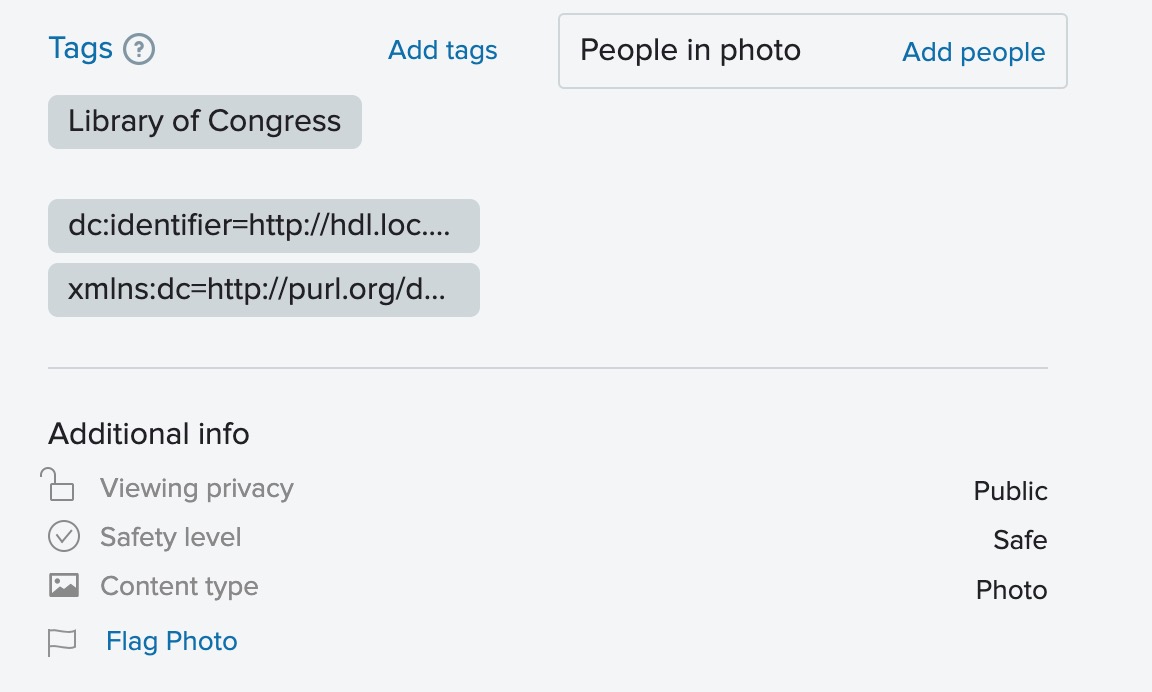
But what about those gibberish ones? I can sense that the dc: indicates Dublin Core metadata and the first one would be my friend, right? the tag is dc:identifier=http://hdl.loc.gov/loc.pnp/ggbain.27141 so if the tag link works, it’s easy to get there from the URL of the LOC page.
Except it doesn’t- the tag url leaves me empty. I go down a deeper rabbit hole testng the tag in an flickr API call for a photo search, and it did seem to retrieve a flickr URL. So the API is one route. Then I had to go eat dinner and come back to this later.
That’s when I started thinking of a bookmarklet search tool, it seemed like a flickr search on the title listed on the LOC page got me results, and I even go the right javascript document selector to find it. But that’s when the proverbial light bulb went off over my head, just another variant of my bookmarklet tool could do this even easier. It actually took about 20 minutes to build.
This now works just as easy, and rather than a single use tool for me to located LOC images in flickr commons, it maybe as a wider use. The way it fits for me is when looking at one of these curious photos that came up in my browser tab (I have a thing for kitchen metaphors).
I can just select text in the page, whack my bookmarklet tool, and find the image in a flickr commons search result
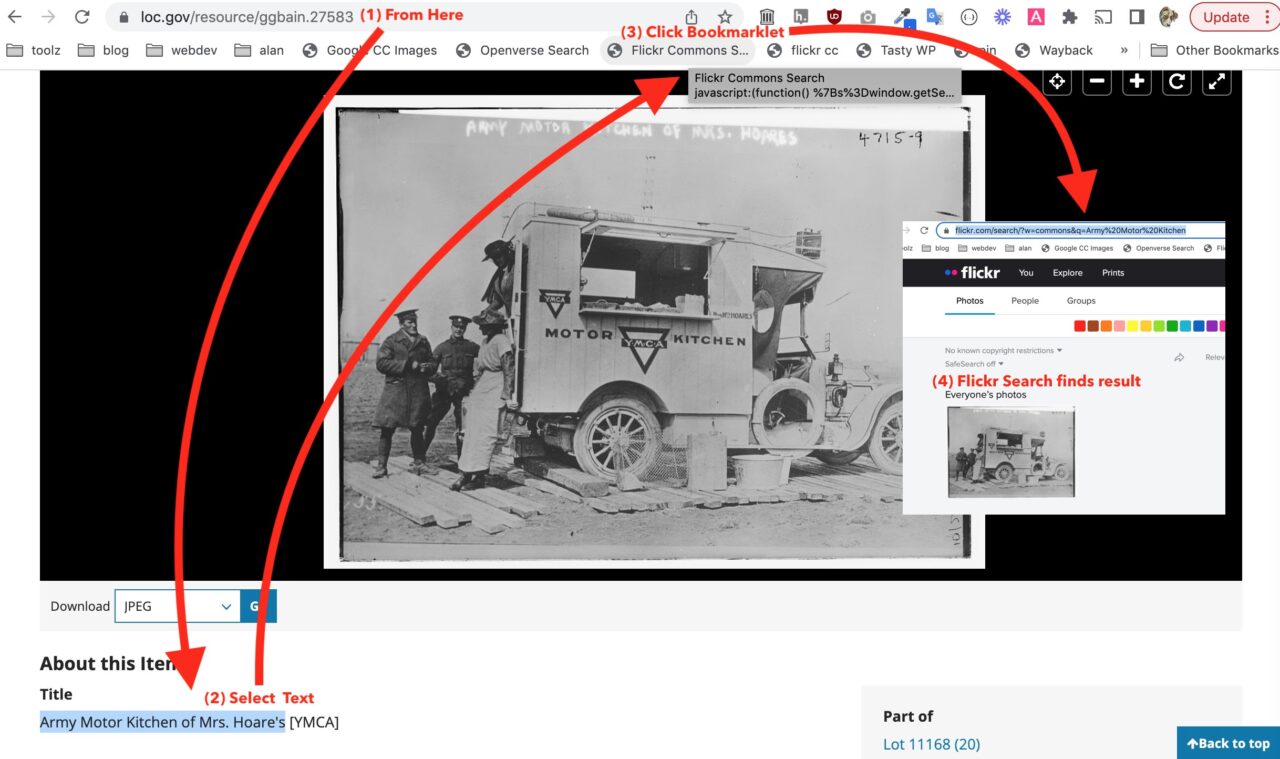
As a caveat a search on the the entire title string did not work! I leave it as an exercise for the reader (all 1 of you?) to follow the search on Army Motor Kitchen, and the comments will explain what the public added to correct the LOC record.
Edyth and Friends…
I would like to think Edyth and her Police Reserve friends are saluting the wealth of not just images in the Flickr Commons, but the comment space where anyone can add, contribute information or commentary. As stories, typically this is stuff that would not neatly fit into a meta data record. It’s messy and delightfully human.
And it’s fantastic to go from a random image in a browser tab to a Library of Congress record to a flickr post, all generated by a curiosity of a random photo. I learn here that many more LOC images are in the Flickr commons than their records indicate, but my little tool here bridges the gap.
It provides me a useful window not just into the LOC photos in the Flickr Commons but everything.
One thing that happens with that Free to Use Extension is I have repeatedly seen classic small town historic photos of Pie Town, New Mexico. Now with my tool I can easily see and link to them all. And I remember a drive across New Mexico highway 60, stopping to see the giant satellite dishes, but being too much of a hurry to stop in the curious spot named Pie Town. The LOC images are part of the large pool of roadside America photos by legendary Farm Security agency photographer Russell Lee and the last trip down this rabbit hole landed me on a fantastic article about this place.
This is what opening a browser tab can do when you make it an opportunity space for curiosity. That is the web I live for.
Featured Image:
